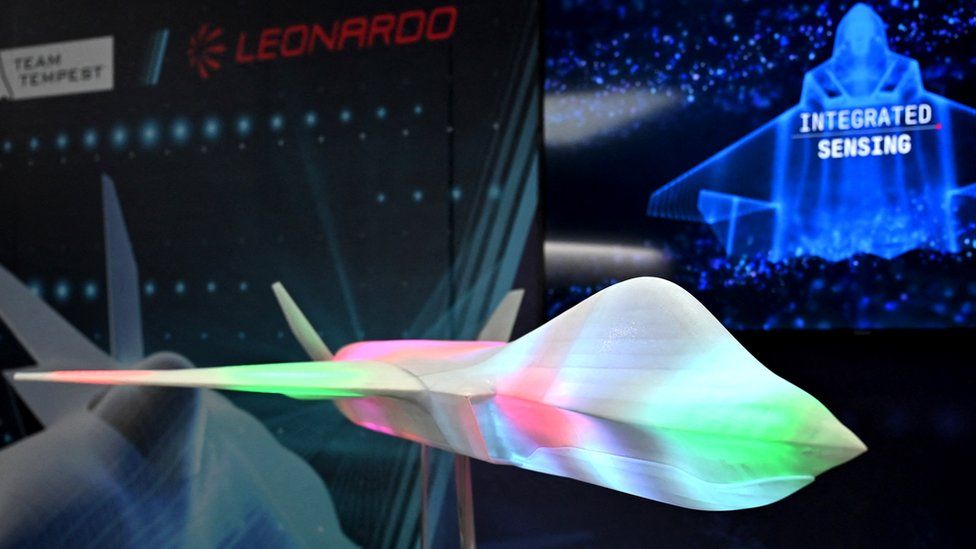By Michael Dempsey
Expertise of Trade reporter
 Picture supply, Getty Photographs
Picture supply, Getty Photographs
A demonstrator model of the Tempest is attributable to hover in 2027
In some unspecified time in the way forward for World Battle II, Spitfire pilots described their airplane as so responsive it felt treasure an extension of their limbs.
Fighter pilots of the 2030s, nonetheless, might maybe presumably fetch a good nearer relationship with their fighter jet.
This will learn their minds.
The Tempest jet is being developed by the UK’s BAE Techniques, Rolls-Royce, European missiles group, MBDA and Italy’s Leonardo.
One attribute might be an artificial intelligence (AI) instrument to abet the human pilot after they’re overwhelmed, or beneath monstrous stress.
Sensors throughout the pilot’s helmet will monitor thoughts indicators and totally totally different medical information. So, over successive flights the AI will amass a mountainous biometric and psychometric data database.
This library of the pilot’s ordinary traits methodology the on-board AI might be able to step-in and abet if the sensors repeat they might maybe want abet.
As an illustration, the AI might maybe steal over if the pilot loses consciousness attributable to excessive gravity forces.
On the Farnborough Air Present, BAE Techniques acknowledged that by 2027 this might sometimes be flying a demonstrator jet from its Warton plant in Lancashire that may verify a majority of those applied sciences.
This plane could possibly be a check-mattress for a number of totally totally different digital capabilities – amongst 60 totally totally different demonstration initiatives, only a few of which is spellbinding to be solely application-essentially based mostly.
Picture supply, Reuters
When images of the Tempest have been first launched in 2018 it was dubbed the “pregnant pelican”
The seems to be wish to be like of the Tempest plane has matured since early images have been first launched of it in 2018. Amongst deal of points Its weight has been diminished and its define slimmed down.
When it in the long run takes to the skies, the Tempest is many instances robotically flanked by un-crewed battle drones, described as ‘adjuncts’ by the Tempest consortium.
Such advances would require solely contemporary strategies of monitoring and abet watch over to be constructed from scratch.
“We now should deal with the hobble of change in experience” says John Stocker, Tempest’s business sample director.
“Within the earlier, defence spending many instances drove advances, with industrial experience catching up later. Now, industrial experience is normally further developed.”
Mr Stocker envisages developing the contemporary fighter with strategies that may furthermore be upgraded as with out issues as downloading an app onto a smartphone.
Picture supply, Getty Photographs
The supersonic Tempest’s predecessor the Storm fighter jet
Within the interval in-between, grand of the manufacturing of the jet might be computerized. Robots on the manufacturing line will fragment information with suppliers, so features might maybe furthermore be swiftly dispatched.
The challenge might additionally glimpse BAE Techniques and Leonardo co-characteristic with Japan’s Mitsubishi – Mitsubishi’s F-X future fighter challenge has grand in frequent with Tempest.
That may be a contemporary expertise for European aerospace corporations, however larger cooperation with Japan has been made likely as a result of initiatives exist in a digital realm.
“You might maybe discontinue these devices hundreds sooner in a digital environment, collaboration is so much easier. We’re not carrying briefcases between Tokyo and Warton,” Mr Stocker jokes.
A group of interpreters and employees who can speak fluently in each English and Japanese on deeply technical issues retains the alliance with Mitsubishi’s F-X fighter group going.
Leonardo’s Edinburgh-essentially based mostly radar arm might be working with Mitsubishi.
The favored considered radar as a rotating dish, scanning ahead and bouncing indicators off impending objects, has given method to digital examination of sensor information.
On the alternative hand the sensors protect pack up a great distance too grand ingredient for a human thoughts to evaluate, which is why AI has transform severe in analysing and processing the torrent of information.
Within the Tempest, it’s miles hoped AI will act as a further or a lot much less gatekeeper, combating the pilot from turning into overwhelmed by incoming intelligence.
The entire challenge is being devised in parallel with weapons producer MBDA. Missiles might be launched from a Tempest however handed over to at the least one among its robotic adjuncts for redirection to a further urgent map.
Picture supply, Getty Photographs
Rolls-Royce will fetch and create engines for the Tempest
All of this motion will rely on solely contemporary engines. Rolls-Royce needs to power not upright the Tempest’s flight, however its complete superior, digital diagram. On-board, files-crunching might maybe heat the airplane up treasure an overburdened laptop computer.
Rolls-Royce engineers are plotting the best method to siphon off that heat whereas producing satisfactory power to abet Tempest’s squadron of digital devices buzzing alongside.
“We want to power each side of the diagram,” says John Wardell, Rolls-Royce future programmes director.
The UK authorities has already dedicated £2bn to the Tempest challenge and that resolve will multiply sooner than the jet enters service. However, an obvious construct a matter to stays. Why not upright create further of the current Storm fighter?
BAE Techniques says that by 2040 the UK and its allies will face contemporary threats and extra refined weapons. This requires applicable experience in response. Tempest could possibly be a fighter for the 2nd half of of a digital century.
How affirm-of-the artwork experience is shaping contemporary fighter jets.
The export success of the Storm additionally explains grand of the UK authorities’s enthusiasm for Tempest. The Storm has contributed £21bn to the UK monetary system whereas supporting over 20,000 jobs, after a affirm funding of £12bn, the company claims.
No query each the fighter consortium and the UK authorities might be eager to reap the identical rewards from the next experience of fighter jet.

